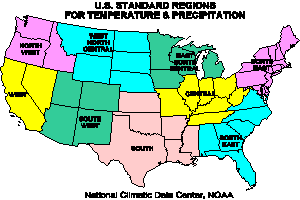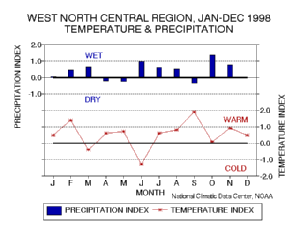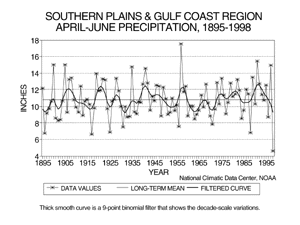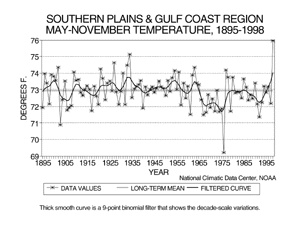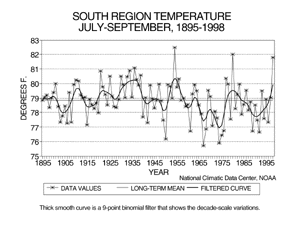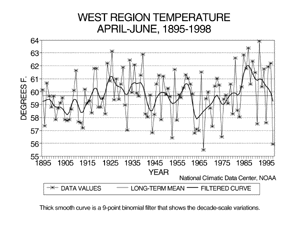|
January 12, 1999


Table 1. PRECIPITATION AND TEMPERATURE RANKS, BASED
ON THE PERIOD 1895-1998. 1 = DRIEST/COLDEST,
104 = WETTEST/WARMEST FOR DECEMBER 1998,
104 = WETTEST/WARMEST FOR NOV-DEC 1998,
104 = WETTEST/WARMEST FOR JUL-DEC 1998,
104 = WETTEST/WARMEST FOR JAN-DEC 1998.
DEC NOV-DEC JUL-DEC JAN-DEC
REGION 1998 1998 1998 1998
------ ---- --------- --------- ---------
PRECIPITATION:
NORTHEAST 7 2 3 73
EAST NORTH CENTRAL 16 38 36 79
CENTRAL 47 30 36 90
SOUTHEAST 45 30 31 81
WEST NORTH CENTRAL 62 91 96 96
SOUTH 54 59 92 64
SOUTHWEST 19 22 69 70
NORTHWEST 81 94 78 99
WEST 13 49 55 103
NATIONAL 33 41 61 100
TEMPERATURE:
NORTHEAST 99 95 98 104
EAST NORTH CENTRAL 91 98 103 103
CENTRAL 88 95 100 103
SOUTHEAST 96 100 103 101
WEST NORTH CENTRAL 73 90 102 100
SOUTH 68 93 102 101
SOUTHWEST 62 79 93 87
NORTHWEST 42 70 103 100
WEST 39 51 76 40
NATIONAL 84 102 104 103

Table 2 shows the 1998 annual values, the annual extremes, and 1961-1990 annual normal precipitation and temperature for the 9 regions and the contiguous U.S. 
TABLE 2. EXTREMES, 1961-90 NORMALS, AND 1998 VALUES
FOR JANUARY-DECEMBER
PRECIPITATION (INCHES)
DRIEST WETTEST NORMAL 1998
REGION VALUE YEAR VALUE YEAR PCPN PCPN
------ ---------- ---------- ------ ------
NORTHEAST 31.77 1930 53.79 1996 41.63 42.54
EAST NORTH CENTRAL 19.81 1910 36.63 1951 30.50 32.08
CENTRAL 30.56 1930 53.38 1990 43.05 47.74
SOUTHEAST 37.56 1954 62.39 1929 51.03 54.48
WEST NORTH CENTRAL 11.49 1934 22.86 1915 16.92 19.90
SOUTH 23.40 1917 46.91 1973 35.72 36.87
SOUTHWEST 7.68 1956 22.10 1941 13.64 14.31
NORTHWEST 19.00 1929 37.30 1996 27.50 32.81
WEST 9.97 1947 31.47 1983 16.51 26.84
NATIONAL 24.17 1910 33.99 1973 29.46 32.61*
* PRELIMINARY VALUE, CONFIDENCE
INTERVAL + OR - .19 INCHES
TEMPERATURE (DEGREES F)
COLDEST WARMEST NORMAL 1998
REGION VALUE YEAR VALUE YEAR TEMP TEMP
------ ---------- ---------- ------ ------
NORTHEAST 43.1 1904 49.3 1998 46.1 49.3
EAST NORTH CENTRAL 39.5 1917 48.0 1931 43.5 47.7
CENTRAL 50.6 1917 56.9 1921 53.2 56.3
SOUTHEAST 61.0 1901 65.0 1921 62.4 64.7
WEST NORTH CENTRAL 39.9 1916 46.7 1934 43.3 45.6
SOUTH 60.4 1979 64.9 1921 62.0 64.5
SOUTHWEST 49.5 1912 54.6 1934 51.8 52.8
NORTHWEST 44.1 1955 50.2 1934 46.7 48.6
WEST 53.0 1911 57.8 1934 55.0 54.6
NATIONAL 50.7 1917 54.7 1934 52.4 54.6*
* PRELIMINARY VALUE, CONFIDENCE
INTERVAL + OR - .0 DEG. F.

Considerable month-to-month variability in precipitation and temperature occurred during 1998. The following bar graphs show the January-December monthly precipitation and temperature anomalies for each of the 9 regions. The precipitation and temperature indices are expressed in terms of standard deviations from the norm: positive values are wet or warm, negative values are dry or cold.


For more information, refer to ... Thomas R. Karl and Albert J. Koscielny, 1982: "Drought in the United States: 1895-1981." Journal of Climatology, vol. 2, pp. 313-329. Thomas R. Karl and Walter James Koss, 1984: "Regional and National Monthly, Seasonal, and Annual Temperature Weighted by Area, 1895-1983." Historical Climatology Series 4-3, National Climatic Data Center, Asheville, NC, 38 pp. NOAA's National Climatic Data Center is the world's largest active archive of weather data. The preliminary temperature and precipitation rankings are available from the center by calling: 828-271-4800 or on the World Wide Web at: http:/www.ncdc.noaa.gov/ol/documentlibrary/cvb.html Historical precipitation and temperature ranking maps are also available on the Internet at: http://nic.fb4.noaa.gov/products/analysis_monitoring/regional_monitoring/usa.html. NOAA works closely with the academic and science communities on climate-related research projects to increase the understanding of El Niño and improve forecasting techniques. NOAA's Climate Prediction Center monitors, analyzes and predicts climate events ranging from weeks to seasons for the nation. NOAA also operates the network of data buoys and satellites that provide vital information about the ocean waters, and initiates research projects to improve future climate forecasts. The long lead climate outlooks are available on the Internet at: http://nic.fb4.noaa.gov.

For further information, contact:
NOAA/National Climatic Data Center 151 Patton Avenue Asheville, NC 28801-5001 fax: 828-271-4328 email: mchangry@ncdc.noaa.gov -or- NOAA/National Climatic Data Center 151 Patton Avenue Asheville, NC 28801-5001 fax: 828-271-4328 email: david.easterling@noaa.gov -or- NOAA/National Climatic Data Center 151 Patton Avenue Asheville, NC 28801-5001 fax: 828-271-4328 email: rquayle@ncdc.noaa.gov  NCDC /
Climate Resources /
Climate of 1998 /
Annual / U.S. Regional Analysis /
Search /
Help
NCDC /
Climate Resources /
Climate of 1998 /
Annual / U.S. Regional Analysis /
Search /
Help
http://www.ncdc.noaa.gov/oa/climate/research/1998/ann/us_regions_main.html Downloaded Sunday, 12-Oct-2008 22:33:58 EDT Last Updated Thursday, 17-Feb-2005 07:21:45 EST by matthew.menne@noaa.gov Please see the NCDC Contact Page if you have questions or comments. |


